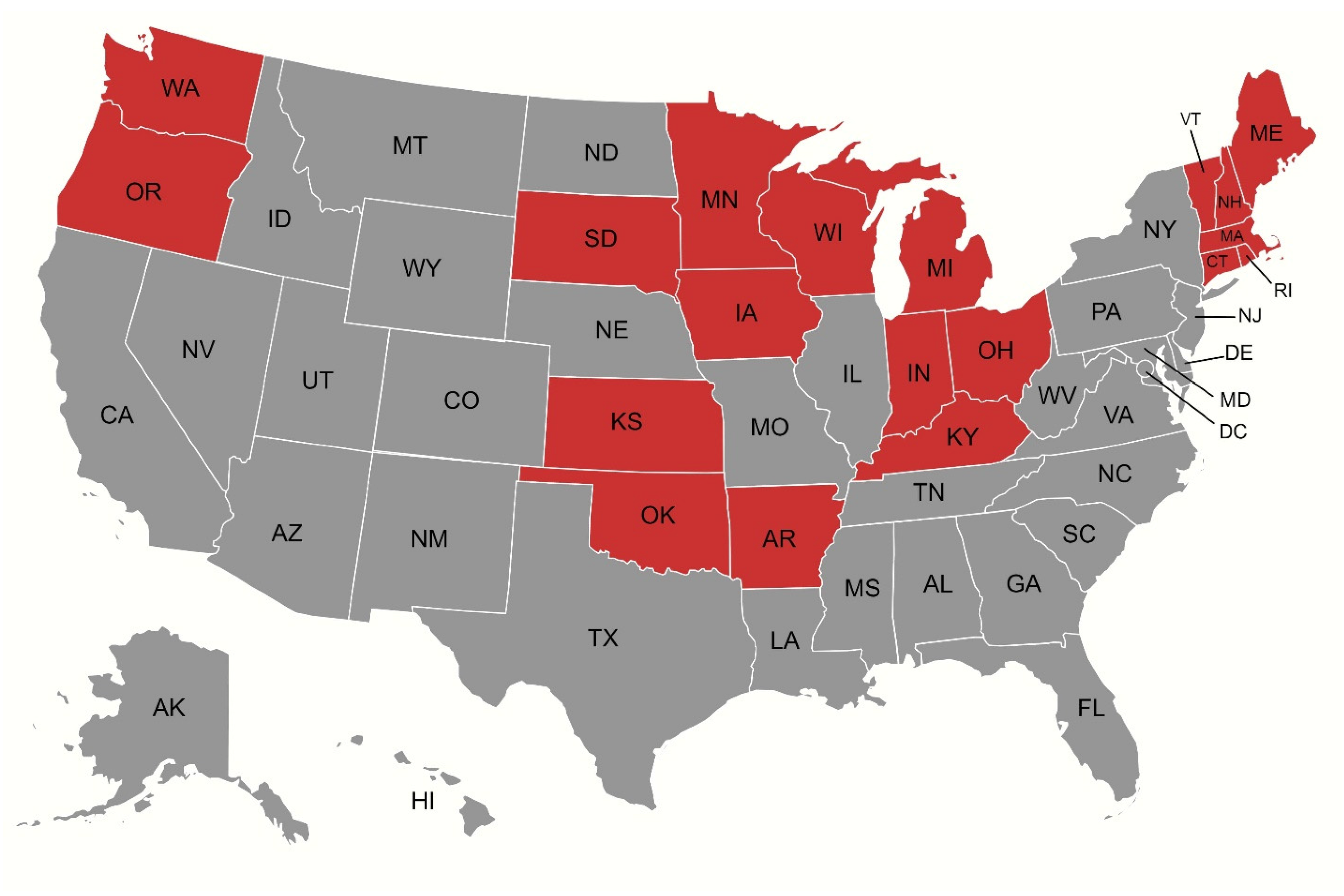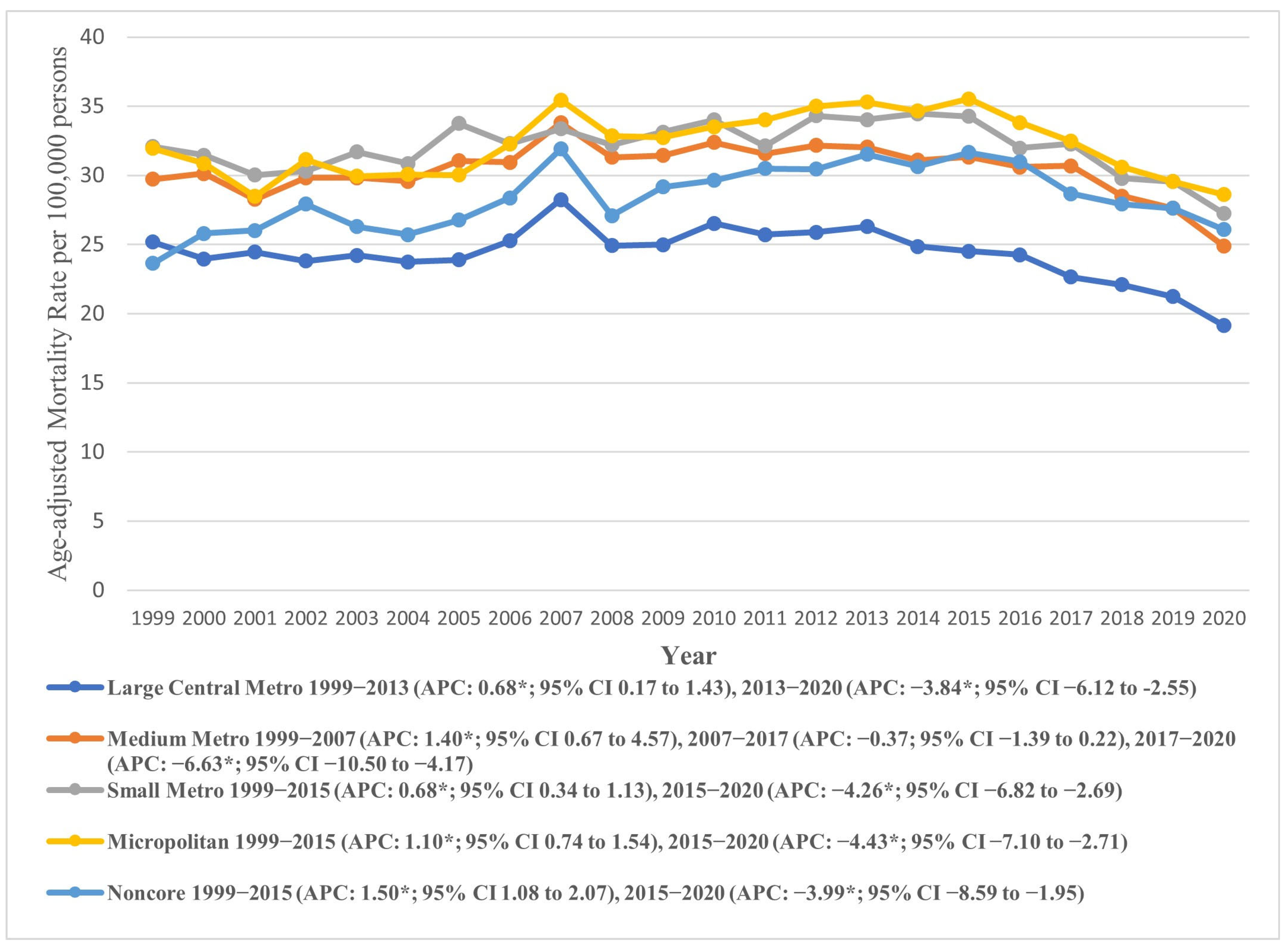Trends in Aortic Stenosis Mortality Among Older Adults in the United States from 1999 to 2020
Abstract
1. Introduction
2. Methodology
3. Study Setting and Population
4. Statistical Analysis
5. Results
6. Annual Trends for AAMR
7. Demographic Trends in AAMR
7.1. Sex-Based Trends
7.2. Racial/Ethnic Trends
7.3. Geographical and Regional Trends Across the U.S.
7.3.1. States
7.3.2. Regions
7.3.3. Urban–Rural Status
8. Discussion
9. Limitations
10. Conclusions
Supplementary Materials
Author Contributions
Funding
Institutional Review Board Statement
Informed Consent Statement
Data Availability Statement
Conflicts of Interest
References
- Osnabrugge, R.L.; Mylotte, D.; Head, S.J.; Van Mieghem, N.M.; Nkomo, V.T.; LeReun, C.M.; Bogers, A.J.; Piazza, N.; Kappetein, A.P. Aortic stenosis in the elderly: Disease prevalence and number of candidates for transcatheter aortic valve replacement: A meta-analysis and modeling study. J. Am. Coll. Cardiol. 2013, 62, 1002–1012. [Google Scholar] [CrossRef]
- Eveborn, G.W.; Schirmer, H.; Heggelund, G.; Lunde, P.; Rasmussen, K. The evolving epidemiology of valvular aortic stenosis. The Tromsø Study. Heart 2013, 99, 396–400. [Google Scholar] [CrossRef] [PubMed]
- Carabello, B.A. Introduction to Aortic Stenosis. Circ. Res. 2013, 113, 179–185. [Google Scholar] [CrossRef] [PubMed]
- Wu, C.; Vasseur, B.; Maisel, W. The March of Transcatheter Aortic Valve Replacement Therapy-US Food and Drug Administration Perspectives on Device Approval for Patients at Low Surgical Risk. JAMA Cardiol. 2020, 5, 5–6. [Google Scholar] [CrossRef]
- Centers for Disease Control and Prevention; National Center for Health Statistics. About Multiple Cause of Death, 1999–2020. Available online: http://wonder.cdc.gov/mcd-icd10.html (accessed on 2 May 2024).
- Hughes, Z.H.; Hammond, M.M.; Lewis-Thames, M.; Sweis, R.; Shah, N.S.; Khan, S.S. Rural-Urban Trends for Aortic Stenosis Mortality in the United States, 2008 to 2019. JACC Adv. 2023, 2, 100617. [Google Scholar] [CrossRef]
- Tung, M.; Nah, G.; Tang, J.; Marcus, G.; Delling, F.N. Valvular disease burden in the modern era of percutaneous and surgical interventions: The UK Biobank. Open Heart 2022, 9, e002039. [Google Scholar] [CrossRef]
- Bevan, G.H.; Zidar, D.A.; Josephson, R.A.; Al-Kindi, S.G. Mortality Due to Aortic Stenosis in the United States, 2008–2017. JAMA 2019, 321, 2236–2238. [Google Scholar] [CrossRef]
- von Elm, E.; Altman, D.G.; Egger, M.; Pocock, S.J.; Gøtzsche, P.C.; Vandenbroucke, J.P. Strengthening the Reporting of Observational Studies in Epidemiology (STROBE) statement: Guidelines for reporting observational studies. BMJ 2007, 335, 806–808. [Google Scholar] [CrossRef] [PubMed]
- CDC Wonder. Mortality Data—About Multiple Cause of Death. [Internet]. Available online: https://wonder.cdc.gov/wonder/help/mcd.html (accessed on 31 May 2024).
- Ingram, D.D.; Franco, S.J. 2013 NCHS Urban-Rural Classification Scheme for Counties; US Department of Health and Human Services: Washington, DC, USA, 2014; pp. 1–73. [Google Scholar] [PubMed]
- Anderson, R.N.; Rosenberg, H.M. Age standardization of death rates: Implementation of the year 2000 standard. Natl. Vital Stat. Rep. 1998, 47, 1–17. [Google Scholar]
- Joinpoint Regression Program; Version 5.0.2; Statistical Methodology and Applications Branch, Surveillance Research Program, National Cancer Institute: Bethesda, MD, USA, 2023. Available online: https://surveillance.cancer.gov/joinpoint/ (accessed on 20 April 2024).
- Siddiqi, T.J.; Khan Minhas, A.M.; Greene, S.J.; Van Spall, H.G.C.; Khan, S.S.; Pandey, A.; Mentz, R.J.; Fonarow, G.C.; Butler, J.; Khan, M.S. Trends in Heart Failure-Related Mortality Among Older Adults in the United States from 1999–2019. JACC Heart Fail. 2022, 10, 851–859. [Google Scholar] [CrossRef]
- Matteucci, A.; Bonanni, M.; Versaci, F.; Frati, G.; Peruzzi, M.; Sangiorgi, G.; Biondi-Zoccai, G.; Massaro, G. Cardiovascular medicine: A year in review. Minerva Cardiol. Angiol. 2022, 70, 40–55. [Google Scholar] [CrossRef]
- Mahmaljy, H.; Tawney, A.; Young, M. Transcatheter Aortic Valve Replacement. In StatPearls; StatPearls Publishing LLC.: Treasure Island, FL, USA, 2024. [Google Scholar]
- Mack, M.J.; Leon, M.B.; Thourani, V.H.; Makkar, R.; Kodali, S.K.; Russo, M.; Kapadia, S.R.; Malaisrie, S.C.; Cohen, D.J.; Pibarot, P.; et al. Transcatheter Aortic-Valve Replacement with a Balloon-Expandable Valve in Low-Risk Patients. N. Engl. J. Med. 2019, 380, 1695–1705. [Google Scholar] [CrossRef]
- Carroll, J.D.; Mack, M.J.; Vemulapalli, S.; Herrmann, H.C.; Gleason, T.G.; Hanzel, G.; Deeb, G.M.; Thourani, V.H.; Cohen, D.J.; Desai, N.; et al. STS-ACC TVT Registry of Transcatheter Aortic Valve Replacement. JACC 2020, 76, 2492–2516. [Google Scholar] [CrossRef]
- Playford, D.; Schwarz, N.; Chowdhury, E.; Williamson, A.; Duong, M.; Kearney, L.; Stewart, S.; Strange, G. Comorbidities and Symptom Status in Moderate and Severe Aortic Stenosis: A Multicenter Clinical Cohort Study. JACC Adv. 2023, 2, 100356. [Google Scholar] [CrossRef]
- Matteucci, A.; Pandozi, C.; Bonanni, M.; Mariani, M.V.; Sgarra, L.; Nesti, L.; Pierucci, N.; La Fazia, V.M.; Lavalle, C.; Nardi, F.; et al. Impact of empagliflozin and dapagliflozin on sudden cardiac death: A systematic review and meta-analysis of adjudicated randomized evidence. Heart Rhythm. 2025, in press. [CrossRef]
- Tribouilloy, C.; Bohbot, Y.; Rusinaru, D.; Belkhir, K.; Diouf, M.; Altes, A.; Delpierre, Q.; Serbout, S.; Kubala, M.; Levy, F.; et al. Excess Mortality and Undertreatment of Women with Severe Aortic Stenosis. J. Am. Heart Assoc. 2021, 10, e018816. [Google Scholar] [CrossRef]
- Gaglia, M.A., Jr.; Lipinski, M.J.; Torguson, R.; Gai, J.; Ben-Dor, I.; Bernardo, N.L.; Satler, L.F.; Pichard, A.D.; Waksman, R. Comparison in Men Versus Women of Co-morbidities, Complications, and Outcomes After Transcatheter Aortic Valve Implantation for Severe Aortic Stenosis. Am. J. Cardiol. 2016, 118, 1692–1697. [Google Scholar] [CrossRef] [PubMed]
- Antia, A.; Pius, R.; Ndukauba, C.; Zarauz, V.R.; Olafiranye, O. Temporal trends in the utilization and outcome of transcatheter aortic valve replacement across racial and ethnic groups. A Nationwide analysis. Int. J. Cardiol. 2024, 399, 131669. [Google Scholar] [CrossRef] [PubMed]
- Minha, S.; Barbash, I.M.; Magalhaes, M.A.; Ben-Dor, I.; Okubagzi, P.G.; Pendyala, L.K.; Satler, L.F.; Pichard, A.D.; Torguson, R.; Waksman, R. Outcome comparison of African-American and Caucasian patients with severe aortic stenosis subjected to transcatheter aortic valve replacement: A single-center experience. Catheter. Cardiovasc. Interv. 2015, 85, 640–647. [Google Scholar] [CrossRef] [PubMed]
- Crousillat, D.R.; Amponsah, D.K.; Camacho, A.; Kandanelly, R.R.; Bapat, D.; Chen, C.; Selberg, A.; Shaqdan, A.; Tanguturi, V.K.; Picard, M.H.; et al. Racial and Ethnic Differences in the Clinical Diagnosis of Aortic Stenosis. J. Am. Heart Assoc. 2022, 11, e025692. [Google Scholar] [CrossRef] [PubMed]
- Fares, A. Winter cardiovascular diseases phenomenon. N. Am. J. Med. Sci. 2013, 5, 266–279. [Google Scholar] [CrossRef] [PubMed]
- Eveborn, G.W.; Schirmer, H.; Lunde, P.; Heggelund, G.; Hansen, J.B.; Rasmussen, K. Assessment of risk factors for developing incident aortic stenosis: The Tromsø Study. Eur. J. Epidemiol. 2014, 29, 567–575. [Google Scholar] [CrossRef]
- Holford, T.R.; McKay, L.; Jeon, J.; Tam, J.; Cao, P.; Fleischer, N.L.; Levy, D.T.; Meza, R. Smoking Histories by State in the U.S. Am. J. Prev. Med. 2023, 64, S42–S52. [Google Scholar] [CrossRef] [PubMed]






| Year | Overall | Male | Female | NH White | NH Black or African American | NH American Indian or Alaskan Native | NH Asian or Pacific Islander | Hispanic or Latino | Population |
|---|---|---|---|---|---|---|---|---|---|
| 1999 | 9572 | 3462 | 6110 | 8846 | 385 | 18 | 83 | 219 | 34,797,841 |
| 2000 | 9743 | 3439 | 6304 | 9038 | 364 | 18 | 67 | 239 | 34,991,753 |
| 2001 | 9615 | 3461 | 6154 | 8952 | 339 | 15 | 80 | 214 | 35,290,291 |
| 2002 | 9961 | 3575 | 6386 | 9252 | 356 | 20 | 95 | 223 | 35,522,207 |
| 2003 | 10,105 | 3647 | 6458 | 9364 | 365 | 19 | 96 | 250 | 35,863,529 |
| 2004 | 10,175 | 3574 | 6601 | 9419 | 378 | 18 | 102 | 251 | 36,203,319 |
| 2005 | 10,635 | 3702 | 6933 | 9901 | 330 | 21 | 106 | 267 | 36,649,798 |
| 2006 | 11,272 | 4127 | 7145 | 10,402 | 403 | 21 | 133 | 300 | 37,164,107 |
| 2007 | 12,566 | 4803 | 7763 | 11,627 | 461 | 21 | 130 | 319 | 37,825,711 |
| 2008 | 11,939 | 4555 | 7384 | 11,092 | 376 | 29 | 118 | 309 | 38,777,621 |
| 2009 | 12,179 | 4653 | 7526 | 11,223 | 414 | 27 | 145 | 359 | 39,623,175 |
| 2010 | 12,865 | 4940 | 7925 | 11,884 | 415 | 25 | 140 | 383 | 40,267,984 |
| 2011 | 13,113 | 5183 | 7930 | 12,129 | 436 | 35 | 159 | 334 | 41,394,141 |
| 2012 | 13,509 | 5373 | 8136 | 12,397 | 438 | 36 | 180 | 420 | 43,145,356 |
| 2013 | 14,134 | 5681 | 8453 | 12,911 | 472 | 37 | 226 | 470 | 44,704,074 |
| 2014 | 14,066 | 5664 | 8402 | 12,804 | 522 | 39 | 203 | 468 | 46,243,211 |
| 2015 | 14,297 | 5731 | 8566 | 13,024 | 480 | 39 | 211 | 494 | 47,760,852 |
| 2016 | 14,202 | 5783 | 8419 | 12,871 | 526 | 35 | 236 | 497 | 49,244,195 |
| 2017 | 14,070 | 5682 | 8388 | 12,693 | 541 | 38 | 228 | 546 | 50,858,679 |
| 2018 | 13,556 | 5523 | 8033 | 12,170 | 543 | 41 | 247 | 533 | 52,431,193 |
| 2019 | 13,431 | 5485 | 7946 | 12,032 | 526 | 38 | 282 | 538 | 54,058,263 |
| 2020 | 12,510 | 5368 | 7142 | 11,167 | 536 | 38 | 220 | 538 | 55,659,365 |
| Total | 267,515 | 103,411 | 164,104 | 245,198 | 9606 | 628 | 3487 | 8171 | 928,476,665 |
Disclaimer/Publisher’s Note: The statements, opinions and data contained in all publications are solely those of the individual author(s) and contributor(s) and not of MDPI and/or the editor(s). MDPI and/or the editor(s) disclaim responsibility for any injury to people or property resulting from any ideas, methods, instructions or products referred to in the content. |
© 2025 by the authors. Licensee MDPI, Basel, Switzerland. This article is an open access article distributed under the terms and conditions of the Creative Commons Attribution (CC BY) license (https://creativecommons.org/licenses/by/4.0/).
Share and Cite
Ahmad, M.; Zahid, S.; Shehzad, M.; Shehzad, D.; Shalen, E.; Rahmouni, H.; Raza, M.; Basman, C.; Vandyck-Acquah, M.; Kaple, R. Trends in Aortic Stenosis Mortality Among Older Adults in the United States from 1999 to 2020. J. Clin. Med. 2025, 14, 8276. https://doi.org/10.3390/jcm14238276
Ahmad M, Zahid S, Shehzad M, Shehzad D, Shalen E, Rahmouni H, Raza M, Basman C, Vandyck-Acquah M, Kaple R. Trends in Aortic Stenosis Mortality Among Older Adults in the United States from 1999 to 2020. Journal of Clinical Medicine. 2025; 14(23):8276. https://doi.org/10.3390/jcm14238276
Chicago/Turabian StyleAhmad, Muhammad, Salman Zahid, Mustafa Shehzad, Dawood Shehzad, Evan Shalen, Hind Rahmouni, Muhammad Raza, Craig Basman, Marian Vandyck-Acquah, and Ryan Kaple. 2025. "Trends in Aortic Stenosis Mortality Among Older Adults in the United States from 1999 to 2020" Journal of Clinical Medicine 14, no. 23: 8276. https://doi.org/10.3390/jcm14238276
APA StyleAhmad, M., Zahid, S., Shehzad, M., Shehzad, D., Shalen, E., Rahmouni, H., Raza, M., Basman, C., Vandyck-Acquah, M., & Kaple, R. (2025). Trends in Aortic Stenosis Mortality Among Older Adults in the United States from 1999 to 2020. Journal of Clinical Medicine, 14(23), 8276. https://doi.org/10.3390/jcm14238276






